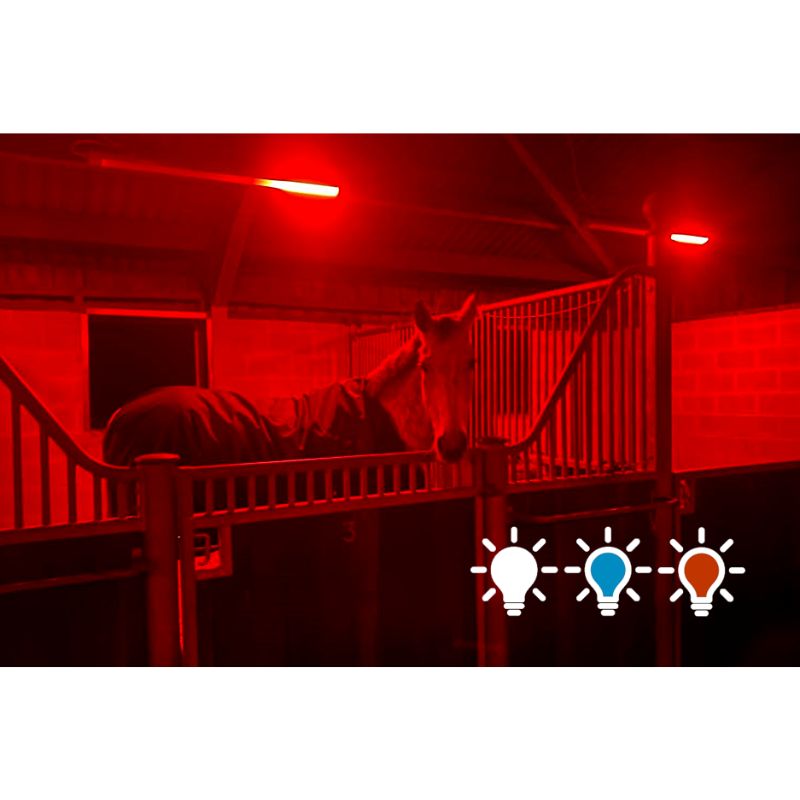
Vitafloor HorseLight Advanced Horse Barn Lights
Ever wonder what your horse's lighting says about its health, energy, and performance? The Vitafloor Horse Light Advanced isn't just a barn light; it's a scientifically designed system that supports your horse's body clock, energy balance, and overall well-being. By combining the power of blue and red light spectrums, this lighting system creates an environment that mirrors natural daylight and night cycles, optimizing rest, recovery, and performance all year long.
The HorseLight Advanced delivers precise wavelengths that regulate melatonin, "the hormone of darkness", which plays a central role in your horse's Circadian Rhythm. This natural daily rhythm influences biological functions such as sleep, immunity, metabolism, and mood. Horses kept indoors often experience low daytime light levels and exposure to bright white light at night, both of which disrupt this delicate rhythm. The result? Fatigue, irritability, poor coat condition, and reduced performance. That's where HorseLight changes everything.
Red Light for Horses: Is your stable lighting helping your horses rest and recover, or keeping them awake?
The Red Light for Horses function in the HorseLight Advanced system was developed using findings from research by Murphy et al. (University College Dublin), which confirmed that low-intensity red light at night (around 625 nm) allows melatonin levels to rise naturally, just as they do in complete darkness. This ensures horses experience true rest without the harmful effects of white light at night.
Melatonin regulates rest, immune strength, and recovery. When nighttime lighting includes red wavelengths instead of white, your horse's body naturally shifts into its nighttime recovery mode, repairing tissue, boosting immunity, and preparing for the next day's workload. The HorseLight Advanced's dim red light provides just enough illumination for foaling, late-night checks, or feeding routines without disturbing the horse's internal clock.
Research trials demonstrated that horses under red light maintained the same melatonin rhythms as those kept in darkness, confirming that low-intensity red light does not disrupt circadian or seasonal regulation. That means your horse's natural sleep and recovery patterns stay perfectly intact while you still get the visibility needed to manage your stable safely and effectively.
Horse Stable Lights: Light affects more than sight; it shapes biology.
During the day, the HorseLight Advanced uses blue light in the 465-485 nm spectrum to mimic natural daylight. This specific wavelength suppresses melatonin, helping horses stay alert, active, and focused. It's the same natural mechanism that wakes animals each morning when sunlight hits the retina.
By stimulating the correct photoreceptors in the horse's eyes, the blue light improves daytime alertness, energy, and mood. Horses respond with better feed conversion, improved muscle tone, and enhanced coat condition. The system's automatic daylight cycles ensure consistent, biologically correct lighting, even during shorter winter days, helping stabled horses maintain balance in their circadian rythm all year round.
Independent stdies and owner feedback have shown that consisten light therapy like this leads to:
- Enhanced daytime alertness and improved sleep patterns.
- Longer maintance of summer coats and improved body condition.
- Reduced stable vices such as box walking, waving, and cribbing.
- Better feed conversion, reducing hard feed requirements.
- Stronger immune response and improved respiratory health.
The HorseLight Advanced can illuminate stables up to 14' x 14', and multiple units can be linked to cover larger barns. Up to 20 lights can be connected to one controller, offering seamless automation for entire facilities.
Night Light for Horse Barn: How can you see your horse clearly at night wihtout interrupting its rest?
The red night light function in the HorseLight Advanced gives you the perfect balance; visibility for night checks, feeding, or foaling without compromising your horse's natural melatoning rhythm. Unlike ordinary white LED or fluorescent lighting, this system protects your horse's nightitime recovery while allowing you to manage your stable confidently after dark.
The Advanced Controller automatically transitions between blue daylight and red night modes, aligning light schedules with the seasons. You can also choose manual operation throygh the Basic Controller or even use the lights independently.
Lights for Breeding Mares
For breeding programs, light therapy has additional benefits: it helps broodmares cycle earlier, encourages stronger ovulation patterbs, and assists stallions in developing reproductive capacity sooner. By mimicking longer days through controlled blue light exposure, the system helps maintain the natural thythm of the breeding season, resulting in earlier foals and more predictable breeding cycles.
Why choose Horse Light Advanced?
- Scientifically proven blue and red light therapy for horses
- Supports circadian balance, performance, and coat maintenance.
- Ideal for performance, breeding, and leisure horses.
- Maintains melatonin regulation- rest at night, energy by day.
- Easy set up - link up to 20 lights for larger barns
Create a healthier, happier stable with Vitafloor HorseLight Advanced Horse Barn Lights. Give your Horses the advantage of scientifically balanced light, energy by day, recovery by night.
Your Horse's health, performance, and comfort deserve nothing less.
FAQ
1. When should mares be put under lights for breeding?
To successfully bring mares into breeding condition earlier in the year, it's best to begin a light exposure program about 60-90 days before the desired breeding date. This duration allows the mare's natural reproductive hormones to respond to the stimulated "longer days." Artificial blue light, such as that produced by the Vitafloor HorseLight Advanced, mimics natural daylight (465-485 nm) and helps regulate circadian rhythm by suppressing melatonin production during the day. Over several weeks, this shift stimulates the hormonal changes necessary for the mares to begin cycling regularly.
This 90-day guideline is supported by the equine reproductive studies showing that mares need approximately two to three months of extended daylight (around 16 hours per day) to activate their normal breeding cycles (McKinnon & Squires, Equine Reproduction, 3rd ed. 2011).
2. How long should horses be under lights?
To maintain optimal biological seasonal cycles, horses should be under light about 16 hours per day, mimicking natural summer daylight conditions. Light therapy typically continues for 8 to 12 weeks, depending on your goal, whether it's promoting early cycling in broodmares, maintaining summer coats, or supporting consistent performance and alertness in competition horses. The HorseLight Advanced Controller automatically regulates day and night cycles, ensuring perfect timing every day of the year.
3. What does blue light do for horses?
The blue light spectrum (465-485 nm) plays a crucial role in maintaining your horse's circadian rhythm. It suppresses melatonin during the day, improving alertness, focus, and energy, while also supporting vitamin D synthesis and feed conversion efficiency. Studies have shown that horses exposed to correct blue light levels experience enhanced performance, better coat condition, and reduced stress behaviors such as box walking and weaving. In short, blue light keeps your horses energized, balanced, and biologically tuned.
4. Do horses like light on at night?
No, horses require darkness or low-intensity red light at night to rest and recover properly. Exposure to white or bright light at night disrupts melatonin production and can lead to fatigue, irritability, and weakened immunity. Research from (2015) demonstrated that dim red light (625nm, 5 lux) allows melatonin levels to rise naturally, just like in complete darkness. That's why horseLight Advanced uses a red night mode that provides visibility for foaling or late check without disturbing the horse's rest.
5. Do horses like blue color?
Horses respond positively to blue light because it mirrors natural daylight and helps maintain alertness and stable circadian rhythms. While horses see the world differently from humans, their dichromatic vision allows them to clearly perceive blues and yellows, while reds and greens appear as shades of gray. Research also suggests that horses show a preference for light-toned blue shades. For example, studies found they tend to drink more from turquoise or light blue water buckets compared to those in red or green tones. This preference indicates that blue hues fall comfortably within their visible range and contribute to a more calming, naturally lit environment that supports both comfort and biological balance.
6. What are the benefits of red light therapy for horses?
Red light therapy supports rest, recovery, and hormonal balance. The red night light function in HorseLight Advanced helps maintain the nocturnal rise of melatonin, essential for immune strength, cellular repair, and deep rest. Research has confirmed that low-intensity red light does not suppress melatonin and therefore doesn't interfere with the horse's natural sleep and regeneration process. This makes it ideal for nighttime management, especially during foaling, feeding, or medical checks.
7. How does HorseLight Advanced improve horse performance?
Performance horses often spend long hours indoors, missing exposure to natural daylight. The HorseLight Advanced delivers scientifically precise lighting that supports energy during the day and recovery at night. Owners have reported better muscle development, improved feed conversion, and calmer behavior. Stabilizing circadian rhythms helps horses stay focused, perform consistently, and recover faster after training or competition.
8. Can light therapy affect a horse's coat condition?
Yes. Controlled light exposure directly influences coat growth and shedding cycles. Studies, including one from Texas A&M University, demonstrated that horses exposed to 16 hours of light daily showed slower coat growth and maintained a smoother, glossier summer coat longer than horses under natural light. The HorseLight Advanced system keeps the coat sleek through autumn and encourages earlier spring shedding, reducing the need for frequent clipping.
9. Is red light safe for horses at night?
Absolutely. Low-intensity red light (around 625 nm) has been scientifically proven to be safe and non-disruptive. Studies have shown that red light allows melatonin levels to rise naturally throughout the night, maintaining the horse's circadian rhythm. This means red lighting can be safely used in stables to provide nighttime visibility for caretakers without disrupting rest, recovery, or overall biological balance in horses.
10. Why choose Vitafloor HorseLight Advanced over regular stable lights?
Standard LED or fluorescent lights may illuminate a barn, but they don't support biological health. The Vitafloor horseLight Advanced delivers the exact wavelengths and lux levels required to regulate melatonin, boost performance, and stabilize the horse's circadian rhythm. It's built for performance, breeding and leisure horses, with automation that mimics natural daylight and red night cycles, providing energy by day, rest by night, and wellness year-round.
The need-to-know
- 3-year guarantee
- Weight: 5.5 lbs.
- Delivers correct lux levels to support health and wellness benefits for a stabled horse.
- Suitable for stables up to 14′ x 14′. Larger stables may require multiple units for optimal performance.
- Compatible with both HorseLight Advanced and Basic Controllers: The Advanced Controller allows automatic daylight and red light switching based on seasonal timers, while the Basic Controller offers easy manual control.
- You can link up to 20 lights with one controller.
- Optional use without a controller, though this disables the automatic timer and infrared function.
- Red night light function is ideal for foaling and late-night checks, providing observation light without disturbing melatonin levels or sleep cycles.










